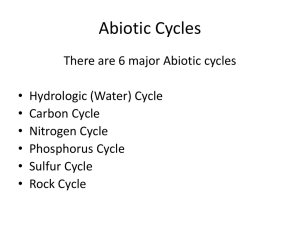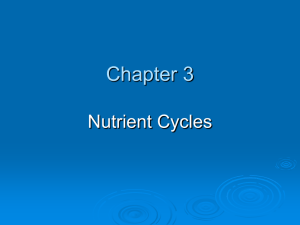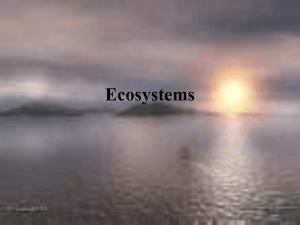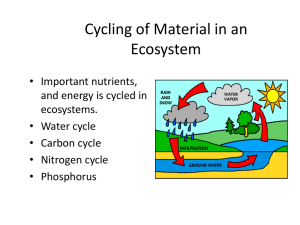Biogeochemical Cycles - Cal State LA
advertisement
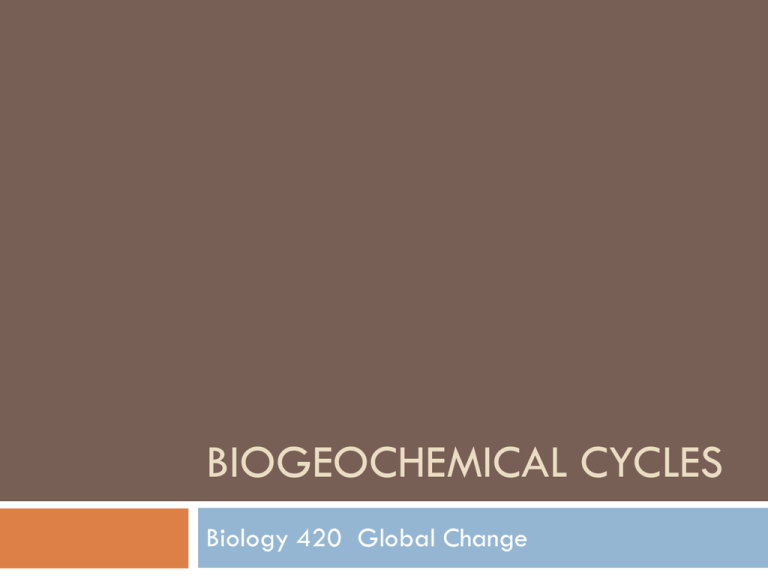
BIOGEOCHEMICAL CYCLES Biology 420 Global Change Introduction Remember Lithosphere Hydrosphere Atmosphere Biosphere Earth is exposed to cyclic phenomena Daily rotation/annual revolution Variations in orbit – glacial cycles Plant photosynthesis/respiration cycles Water cycle Generalized Biogeochemical Cycles Major parts of the biosphere are connected by the flow of chemical elements and compounds. Exchanges of materials between these different reservoirs Between atmosphere and biota/oceans can be rapid Between rocks, soils and oceans can be more slow. What is being exchanged? Major Elements Six elements account for 95% of biosphere C, H, O, N, P, S In 1958, Albert Redfield published a paper of great importance to marine biogeochemistry Fairly constant molar ratio of N and P in phytoplankton C106N16P (known as the Redfield Ratio) also C106O138N16P Major Element Cycles There are others – iron, metals, Ca/Si for example Here we will consider these: C, H, O, N, P, S Water Cycle last time (H2O) Today Carbon Cycle Nitrogen Cycle Phosphorus Cycle Sulfur Cycle Let’s Start with Carbon More than 1 million known carbon compounds Unique ability of carbon atoms to form long stable chains makes life possible Oxidation states ranging from +IV to –IV most common is +IV as in CO2 and carbonate CO in trace levels in atmosphere is +II Assimilation of carbon by photosynthesis creates reduced carbon CH2O CH4, also trace gas is –IV More on Carbon Seven isotopes of carbon Carbon Reservoirs Reservoir: In geochemistry, a reservoir is the mass of an element (such as carbon) or a compound (such as water) within a defined “container” (such as the ocean or the atmosphere or the biosphere). Atmosphere Hydrosphere (oceans) CO2 – based on a CO2 concentration of 351.2 ppmv in 1988 corresponds to 747 Pg of carbon (1 Pg= 1015g) CH4 – based on CH4 concentration of 1.7 ppmv in 1988 corresponds to 3 Pg of carbon (most abundant organic trace gas and 2nd most important changing greenhouse gas) CO –ranging from 0.05 to 0.20 ppmv 0.2 Pg carbon Dissolved inorganic carbon (DIC) 37,900 Pg C Dissolved organic carbon (DOC) 1000 Pg C Particulate organic carbon (POC) 30 Pg C Marine biota 3 Pg C Terrestrial Biosphere ranging from 480 – 1080 Pg C Lithosphere – carbon in rocks, fossil fuels huge reserves 20 million Pg C in rocks, 104 Pg C in extractable reserves of oil and coal Carbon Flux Nitrogen Coupled with other elements of living matter (such as carbon) Important biological and abiotic processes Oxidation states from +V to –III Not found in native rocks, major reservoir is N2 in atmosphere Biological Transformation of Nitrogen Compounds (microbial mediation) Nitrogen fixation enzyme-catalyzed reduction of N2 to NH3, NH4+ or any organic nitrogen Ammonia assimilation uptake of NH3, NH4+ Nitrification oxidation of NH3, NH4+to NO2- or NO3as a means of producing energy Assimilatory nitrate reduction reduction of NO3then conversion to biomass Ammonification organic nitrogen to NH3 or NH4+ Denitrification reduction of NO3- to N2 or N2O (nitrous dioxide, gaseous forms) Reservoirs and Fluxes More Nitrogen NOx NO (nitric oxide) and NO2 (nitrogen dioxide) Formed due to reactions of N and O in air during combustion Air pollution and reactions to form acid rain Atmospheric deposition: elements of biogeochemical interest deposited on Earth as rainfall dry deposition (sedimentation) direct adsorption of gases Processes of Nitrogen Gas Emissions Rapid conversion of NH4+ to NH3 at high pH and low soil moisture results in gas loss to atmosphere High organic waste loads (from feedlots) promote NH3 loss NO, N2O are byproducts of nitrification NO, N2O and N2 are products of denitrification Atmospheric N Deposition Acidic wet and dry deposition due to combustion NH4+ from livestock organic waste Wet Deposition NO3/NH4 (2009) Phosphorus Second most abundant mineral in human body (surpassed only by Ca) This cycle has no atmospheric component (gaseous P3 is negligible) Restricted to solid and liquid phases (many mineral reactions) Unlike nitrogen, not really involved in microbial reactions Oxidation-reduction reactions play a minor role in reactivity and distribution of phosphorus Only 10% of phosphorus from rivers to oceans is available to marine biota It is suggested that terrestrial net primary productivity is determined by level of available phosphorus in soil P in low concentrations in rocks N abundant in atmosphere Other essential plant nutrients are more abundant than P (S, K, Ca, Mg) Bacteria involved in N cycle require P also More on Phosphorus Forms Dissolved Inorganic Phosphorus PO43Organic Forms phosphate in DNA, RNA, ATP, phospholipid Minerals apatite [Ca(PO4)3OH] Distribution Sediments 4 million Pg P Land 200 Pg P Deep Ocean 87 Pg P Terrestrial Biota 3 Pg P Surface Ocean 2.7 Pg P Atmosphere 0.000028 Pg P Phosphorus Cycle A “sedimentary” cycle with Earth’s crust as reservoir erosion processes they are washed into rivers and oceans Plant and animals adsorption up the food chain… small role in comparison to 1st point Agriculture a limiting nutrient Mined for fertilizer Form of fertilizer is phosphate Also contain nitrogen Sulfur Cycle Essential to life, also relatively abundant and thus not limiting Like phosphorus, has important geochemical cycling Like nitrogen Important gas phases Oxidation-reduction reactions and oxidation state from -II to +VI Sulfur Cycle Sulfur Reservoirs The crust as gypsum (CaSO4) and pyrite (FeS2) Distribution 2 x 1010 Tg S Ocean: 1.3 x 109 Tg S Ocean Sediments: 3 x 109 Tg S Marine Biota: 30 Tg S Soils and Land Biota: 3 x 105 Tg S Lakes: 300 Tg S Continental Atmosphere: 1.6 Tg S Marine Atmosphere: 3.2 Tg S Lithosphere: Sources of Sulfur in Atmosphere Volcanic eruptions 12-30 Tg S averaged over many years Tambora, Indonesia in 1815, 1816 – year without summer ~50 Tg S Soil dust Biogenic gases Anthropogenic emission Marine Sulfur Cycle Ocean is large source of aerosols (sea salts) that contain SO42- (mostly re-deposited onto ocean) DMS dimethyl-sulfide (CH3)2S is a major biogenic gas emitted from sea Produced during decomposition of dimethylsulfonpropionate (DMSP) from dying phytoplankton Small fraction is lost to atmosphere Oxidation of DMS to sulfate aerosols greater cloud condensation nuclei more clouds Layer of sulfate aerosols (Junge layers) 20-25 km altitude Microbial Action Assimilative reduction of SO4- to –SH groups in proteins Release of –SH to form H2S during excretion, decomposition and desulfurylation Oxidation of H2S by chemolithotrophs to form elemental sulfur or SO4Dissimilative reduction of SO4- by anoxygenic phototrophic bacteria


